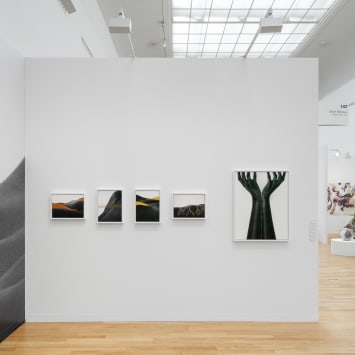Presented alongside this series, the installation Nero Sangue [Black Blood] extends this reflection through a sculptural language. Composed of tomatoes painted in glossy black and gathered into a dense heap, the work condenses multiple readings: those of body and blood, fruit and soil, labor and memory. Through their dark hue and almost liquid sheen, these tomatoes become metaphors for agricultural labor, migration, and the invisibilization of Black bodies within contemporary economic and social systems. The progressive decay of the installation is an integral part of the work: it expresses the fragility of living matter, the passage of time, but also the unequal struggles for survival within a two-tiered system. By altering the color of the fruit, the artist turns it into an ambivalent symbol — poised between vitality and mourning, fertility and exploitation.
For her first participation in Art Basel, Binta Diaw continues her exploration of the body as a sensitive territory and a space of memory. The works, produced from the artist’s photographic prints, reveal fragments of skin, hands, curves, and folds, captured in a light that gives the surface of the body an almost mineral density. Photographed in close-up and framed with precision, these bodily fragments become abstract expanses of land. Upon these epidermal landscapes, Diaw applies her delicate graphic interventions — stems, braids, branches, or fruits — which redefine the relationship between nature and humanity, matter and symbol. Each image offers an intimate geography where life unfolds: a plant seems to sprout along an arm, a braid traverses a valley of flesh, fruits emerge from a topography of skin. These simple gestures establish a resonance between the organic and the spiritual, between bodily memory and the inscription of life within matter.
Paysages corporels [Corporeal Landscapes] series extends the central concerns of Binta Diaw’s practice: migration, belonging, diasporic identity, and collective memory. Through a refined compositional language, the artist constructs a reflection on lineage and transmission — on how bodies, particularly Black bodies, carry within them the traces of multiple histories and of violences that are sometimes obscured. By associating the Black and feminine body with the fertility of the soil, Diaw offers a poetic and political rereading of the notion of roots, no longer as a fixed anchor but as a fluid and proliferating network.
The artist’s manual interventions on the prints lend each work a tactile and sensory dimension. They embody gestures of reappropriation and care. Against the whiteness of the background, the body rises as a territory; the landscape becomes skin, and skin, in turn, becomes a site of rootedness and emancipation.
By proposing a new cartography of the body, Binta Diaw articulates a vision of the world in which the boundaries between nature and culture, the intimate and the collective, dissolve in favor of an ecology of relation.
